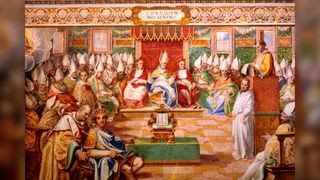Easter, unlike Christmas, is a holiday with a shifting date. This peculiarity often leads to the question: Why Does The Date Of Easter Change? The answer lies in a complex history involving astronomical events, early church debates, and calendar discrepancies. Let’s delve into the fascinating reasons behind Easter’s fluctuating date.
 A painting of the Council of Nicaea in A.D. 325
A painting of the Council of Nicaea in A.D. 325
The Early Church and the Passover Connection
Early Christians initially celebrated Easter on different dates. While all agreed that Easter commemorated Jesus Christ’s resurrection, disagreements arose regarding the specific day. Some early Christians in Asia Minor linked Easter to the Jewish festival of Passover (Pesach), which celebrates the liberation of the Jewish people from slavery in Egypt. Passover begins on the 15th of Nisan in the Jewish calendar, corresponding to the first full moon of spring.
The Western Church and the Sunday Tradition
Western Christians, however, observed Easter on the first Sunday following Passover, associating Good Friday with the crucifixion two days prior. This difference in calculation often led to discrepancies in the date of Easter between Eastern and Western churches. All other related observances, such as Palm Sunday, are determined based on the date of Easter.
The Council of Nicaea and the Quest for Standardization
In an attempt to resolve this and other disputes, church leaders convened the Council of Nicaea in A.D. 325. While the council successfully established the Nicene Creed, standardizing core Christian beliefs, the issue of Easter’s date proved more challenging. Although the council aimed to decouple Easter from the Jewish calendar and link it to the vernal equinox (around March 20 or 21), disputes continued for centuries.
The Vernal Equinox and the Modern Calculation
The Council of Nicaea established a formula that remains the basis for calculating Easter’s date today: Easter Sunday is the first Sunday after the first full moon following the spring equinox. This formula places Easter anytime between March 22 and April 25.
Calendar Discrepancies and Continued Variations
While the formula is consistent, the use of different calendars introduces further variations. The Catholic Church and most Protestant churches adhere to the Gregorian calendar, while Eastern Orthodox churches utilize the Julian calendar. This difference in calendars results in different Easter dates being observed in different parts of the world.
Debunking Pagan Origins
Despite popular belief, Easter likely does not have pagan origins. While some suggest a connection to the Anglo-Saxon goddess Eostre, historical evidence is limited. The term “Easter” may simply derive from a root word signifying spring or dawn.
Conclusion: A Complex Calculation with a Rich History
The fluctuating date of Easter reflects a complex interplay of historical, religious, and astronomical factors. From early church debates to calendar discrepancies, the journey to determine Easter’s date has been a long and fascinating one. While the date may change, the core significance of Easter – the celebration of Christ’s resurrection – remains constant.